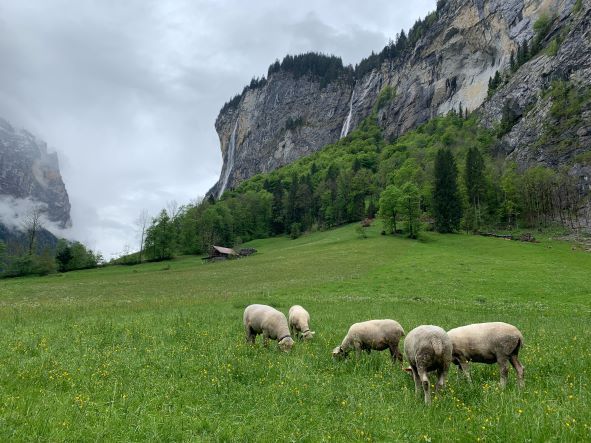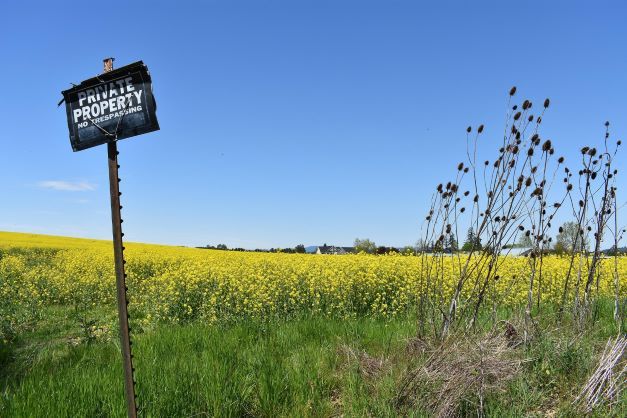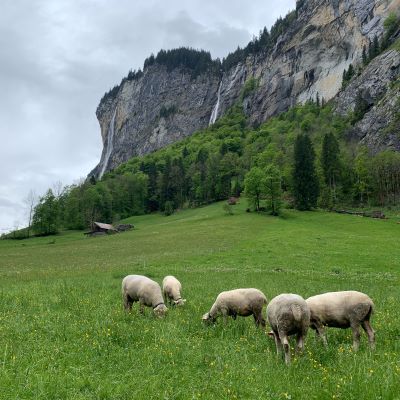by Thorsten Arnold
The land problem
In the early 21st century, Ontario faces a farming question that has haunted Europe for centuries: how to protect and ensure access to agricultural land. On average, the price of Ontario’s agricultural land rose by 22% in 2021 alone; the stretch between Bruce county and Peterborough/Haliburton by 28% (FCC 2022). Marginal land, formerly an entry opportunity for beginning farmers, has slipped out of reach: now these properties get scooped up by urbanites who turn them into cottages. In Ontario, becoming the owner of farmland has long been out of reach for most prospective farmers who are Black, Indigenous, or people of colour. With the recent land price explosion, even people with considerable privilege can no longer purchase farmland — and so the dream of becoming a farmer is more unrealistic than ever. The land question has become the central barrier for Ontario’s young farmers.
The agricultural land narrative as cultural trait – lessons from Europe
The struggle to access land is well known in many European countries. Many have developed strategies and legal framing designed to address this issue. To counter speculation, France, Spain and Portugal restricted the purchase of agricultural land by foreign buyers. Before the French Revolution, land in France had accumulated in the hands of a few aristocrats who used their power to exploit landless peasants. The land reform that followed persists today: all French farmland sales must be approved by Société d’Aménagement Foncier et d’Etablissement Rural (SAFER). SAFER was set up in the 1960s to preserve rural landscapes and fight land speculation and accumulation. Today, SAFER’s supports young farmers and start-ups, and protects landscapes, natural resources, and rural economies. Whenever farmland is offered for sale, SAFER must be notified first. It can then choose to pre-empt the sale by purchasing the farmland — either at the set value or at a lower price that SAFER sets itself. The seller can only accept SAFER’s lower price or take the land off the market. SAFER typically resells land to young local farmers. France’s restrictive management of land accumulation, though only partly successful, builds on a cultural memory that land accumulation will result in a devastating misuse of power by landowners.

In Switzerland, cooperative management is culturally embedded. Alpine pastures in particular are managed cooperatively; good grazing management is essential to stabilize soils, prevent mudslides and avalanches, and protect communities. The Swiss have long recognized that land ownership is a responsibility of the entire community! Hence, land use restrictions are legally enshrined: all uses of agricultural lands are restricted by the Swiss constitution, which prescribes the multifunctional duties of agricultural landowners: “the reliable provision of the population with foodstuffs; the conservation of natural resources and the upkeep of the countryside; decentralized population settlement of the country”. (Source: The Swiss Agency for Development and Cooperation). The Swiss constitution explicitly empowers the government to expropriate private property in order to enforce the commons.
Swiss federal law also limits the purchase of agricultural land to agricultural producers. These must be the managers of their agricultural enterprises and, in addition, live within 10 kms of the farmland. Land rental can only occur if farmers retire or their heirs are not farming themselves. Furthermore, the law ensures that agricultural land cannot be severed, and land pricing is capped at 5% above the average surrounding land value.
In Germany, larger landowners were strong supporters of the Nazi regime. After WWII, the allied forces planned for a thorough land reform. Expropriations progressed rapidly in Russian-controlled East Germany, where approximately 7 million acres were converted into state-owned collectives. West Germany, then administrated by the same officials as during the Nazi era and still influenced by powerful land owners, only expropriated 500,000 acres and soon abandoned land reform efforts altogether. Like Ontario, Germany’s agricultural sector is now struggling with land accumulation and speculative pricing, much more than its neighbours France or Switzerland.
The French and Swiss examples both demonstrate how proactive governance of land ownership reflects cultural identity and the narrative of the peasant movement. Neither Ontario nor Germany have a similar cultural narrative around land. Land is being accumulated by speculators, and farmers are struggling more every year, every generation.
Land Co-operatives in Europe
In response to the farmland crises throughout Europe, several land access initiatives have emerged. Among the first organizations that address land ownership are France’s Terre de Liens and Germany’s Kulturland Co-op and BioBoden Co-op. These co-operatives, which connect peasant farmers with community investors, have joined forces as Access To Land (ATL), a network of organizations that is dedicated to “raising the bar for land access by agroecological peasant farmers”. ATL recently fostered new initiatives in Catalonia (Terra Franca), Flanders (De Landgenoten), Czech Republic (CooLAND) and Scotland (Scottish Farmland Trust).
These cooperatives generally share the same premise: they help farmers access land by raising money from community. Land is cooperatively owned as a common good, and agricultural practices are restricted by the co-op. For example, Kulturland Co-op requires that farms (1) are certified organic, (2) reserve at least 10% of the land for conservation, and (3) participate actively in community. In exchange, community members provide an interest-free loan to the co-op to purchase land.
Of course, there are country-specific legalities. For each new farmland that Kulturland purchases, the co-op creates a Limited Partnership. In this partnership, the co-op owns the land title, but farmers maintain 90% of the decision power over the land. The farmer has an indefinite use contract, as long as the co-op’s three requirements are met and the low rent is paid. Today, Kulturland co-op can access sufficient capital to purchase land even before a community campaign. Beforehand, farmers must demonstrate that its community will pay 33% of the purchasing value, through written declarations of intent by supporters. After purchase, farmers must actually raise these 33% in their community; the rest is contributed by the co-op. The co-op offers further support: a crowdfunding website, communication and fundraising training, and legal advice.
Kulturland co-op acquired its first capital in the 1970s, when a biodynamic farmer struggled to find a successor who could afford the land. At that time, Kulturland was newly founded and had no assets. A rich anthroposophic customer of the farm provided a 10-year interest-free credit of$2 million, secured with the land. With a first success story to tell, the co-op soon raised more money from many small contributions, and acquired several farms. Today, the coop has 1080 bond holders and owns around 1,000 acres with 26 farm partners.
Understanding the history of Kulturland and the role of cultural narrative
In an interview with biodynamic farmer and Kulturland co-founder Thomas Kliemt-Rippel, Thomas pointed out a recurring theme: a fundraising-oriented cooperative like Kulturland must be embedded within the cultural narratives of the region. Some aspects of this narrative include the responsibility of individuals for our landscapes and for their community; the social responsibilities between rural and urban dwellers, eaters, and farmers; and older and younger generations. Cultures hold unique narratives around the role of collaboration and cooperative management, food, and how individuals value reciprocity.
For community members that pay into a co-op, the main driver for supporting farmers to access farmland are intrinsic values. Members provide a zero-interest bond to purchase the farmland. This bond is paid back after a defined period of time, and members forfeit any income from that capital. Raising bonds is far easier during stable times with low interest rates (in Germany, banks actually charged a “negative interest rate” for having money in a savings account, so the zero% interests were actually an improvement to what banks offered!). As the war in Ukraine has created significant uncertainty in early 2022, community members are increasingly cautious, and community investment has dropped sharply.
Kulturland’s staffing and operating costs are met with a complex strategy, once again embedded into the German cultural narrative. The co-op understands that farmers cannot pay much rent for agricultural land; farmers nevertheless pay 1% per year of the purchasing value of the land they occupy to Kulturland, to contribute to its operating cost. Recently, Kulturland implemented an innovative strategy for retirement savings: its own cooperative pension plan without capital savings. Young staff directly pay part of their income to support retired staff. In exchange, once these young staffers retire, they will benefit from similar payments from future staffers. Price inflation is factored in by orienting future payment at future living cost. This “multigenerational contract” circumvents the need for profit-generating capital investments. With its non-liquifiable land assets, the coop will continue to exist into the future, so Thomas is confident that others will reciprocate and take care of him. Such a “multigenerational contract” is a well-established narrative in German culture: Germans immediately understand and support the concept, and this contract has proven more reliable than US-style capital-based pension funds.
Replicating land commons in North America
In the United States, the European cooperative model was replicated in the Agrarian Trust. The Trust is a national umbrella organization that oversees multiple farm commons. For each of these farms, a not-for-profit is established that holds the land title and supports land tenure for the young generation. A team of young attorneys at Sustainable Economies Law Center was instrumental in getting this started — they translated the European cooperative model into something that works in the US. Based on 10 guiding principles, the Agrarian Trust restricts land uses and farmer liberties, secures equity that farmers build on farms (e.g. buildings) without addressing the retirement issue. Since purchasing its first farm in 2019, the Agrarian Trust now supports dozens of farms — an impressive inspiring feat! The Agrarian Trust also offers toolkits for church communities who want to invite young farmers to utilize their land, detailed guidelines for establishing a Commons farm, and lots of good communication materials.
Replication structures in Ontario
In Ontario, several land trusts exist for preserving agricultural land or conservation. However, Ontario does not have a mechanism that protects land for organic or agroecological farming — nothing resembling the Access To Land network or the US Agrarian Trust.
Several Ontarian farms are currently attempting to formalize collective ownership along various structures. The European experience of the Access To Land forum, however, clearly shows that it is financially difficult to develop a structure for a single farm. Rather, the forum instigates umbrella organizations, each of which can facilitate the transition of multiple farms based on a regulatory blueprint. Beyond legalities, there are several paradigmatic barriers to forming agroecological farmland trusts in Ontario. All of these stem from our cultural narrative, and we have to reflect deeply to understand these barriers.
First, land acquisition was traditionally used as the main savings strategy for farmers’ retirement: the price-inflation of real estate remains the dominant savings strategy within North America’s broader cultural narrative! Collective land ownership means dropping the idea of building assets through real estate speculation. Where Germany’s Kulturland relies on the multi-generational contract narrative, Ontario’s dominant narrative is that retirement savings are based on capital assets, property value explosion, and younger buyers who can afford it. So how will we ensure retirement for farmers in a collective land ownership approach?

Secondly, one of the draws to farming is the “narrative of liberty” — we farmers can do on our land whatever we like. This narrative attracts on the right and on the left alike. In contrast, Germany’s tight regulatory framework, France’s shared memory of its revolution and land reform, and Switzerland’s successful communal land management, all connect land ownership with significant social responsibilities. Within these “responsibility narratives”, farmers understand that their freedoms also come with responsibilities. Ontario’s freedom narrative is a barrier to this sense of responsibility, community obligations, and restricting negotiations.
Finally, the untouchable role of private property is a foundation in Ontario’s settler culture. In France and Switzerland, a history of land reform and expropriation puts this sense of ‘untouchable property’ into perspective. Direct democratic elements are also embedded there, giving communities a sense of agency over their landscape that Ontario is still lacking.
Before adapting any form of collective land ownership to our region, we need to reconsider three aspects of our current cultural narrative: (1) real estate as retirement savings, (2) land ownership as liberty & right, and (3) the untouchable nature of private property. The Agrarian Trust shows how land access approaches can be translated to different cultures if details are adapted accordingly! But participants must open to new narratives. To face the issue of land inequality demands bravery, imagination, and new ways of working together — not easy, in a climate of fear and individualism. Yet worth it, without a doubt.
Thorsten Arnold co-owns Persephone Market Garden. He educates about and advocates for regenerative food systems in all its facets, especially regenerative production systems, co-operative distribution, and restoration of climate-resilient landscapes.

